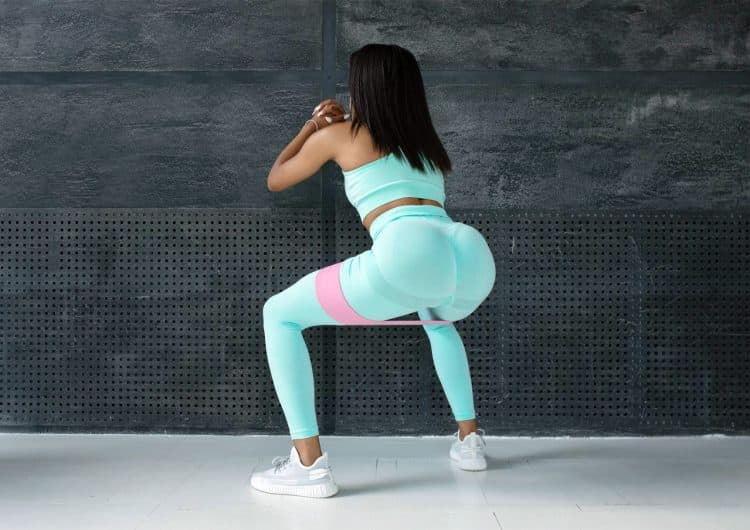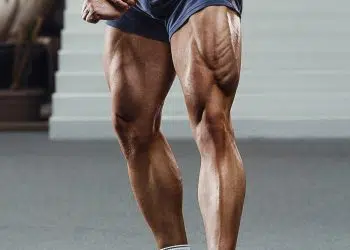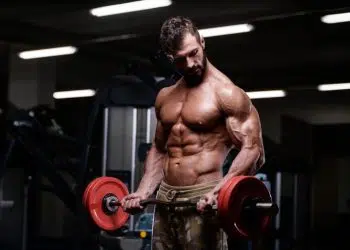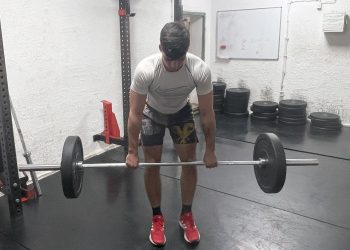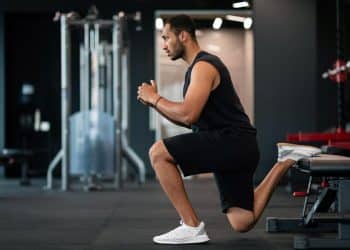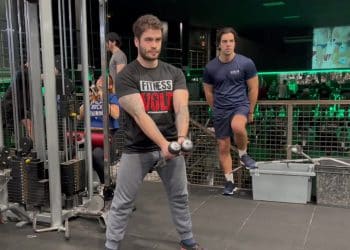The fitness industry often follows trends, and this is nothing new. Diets, workouts, and even sports fall in and out of vogue. For example, step aerobics and Jazzercise have been mostly superseded by CrossFit and HIIT, and a round, firm butt is the new six-pack abs.
And speaking of butts, it’s not enough to have a big rear end; the shape needs to be right too. Currently, that means having well-developed upper glutes.
The upper glutes aren’t just important for appearance. They play an essential part in hip stability and function. Plus, working on your upper glutes could improve your athletic performance.
In my 35 years as an experienced personal trainer, I’m seeing a growing trend among clients seeking to develop more defined and lifted upper glutes, often referred to as the ‘butt shelf.’
In this article, I reveal the 15 best upper glute exercises and a workout to achieve this objective.
Recent Updates: On June 3, 2024, Fitness Volt’s Senior Editor, Vidur Saini (American Council on Exercise-CPT), updated the article and added actionable expert tips throughout the piece to improve the reader experience.
Level Up Your Fitness: Join our 💪 strong community in Fitness Volt Newsletter. Get daily inspiration, expert-backed workouts, nutrition tips, the latest in strength sports, and the support you need to reach your goals. Subscribe for free!
15 Best Upper Glute Exercises
Add the following exercises to your arsenal:
- Barbell Hip Thrust
- Dumbbell Lateral Lunges
- Goblet Sumo Squats
- Single-Leg Romanian Dumbbell Deadlifts
- Bulgarian Split Squats
- Fire Hydrants
- Glute Bridges
- Frog Pump Hip Thrust
- Banded Seated Hip Abductions
- Standing Band Hip Abduction
- Banded Clamshell
- Booty Band Goblet Squat
- Hip Abduction Machine
- Total Hip Machine Abductions
- Cable Machine Hip Abductions
4 Best Upper Glute Exercises with Weights
The great thing about these exercises is that you can increase the load to make them more challenging. This makes them useful for building upper glute muscle size and strength.
1. Barbell Hip Thrust
| Sets & Reps | Equipment Needed | Target Muscles |
| 3-4 x 8-12 | Barbell, Bench | Gluteus maximus, Hamstrings |
The barbell hip thrust is a popular glute exercise. It works the entire posterior chain, including the upper glutes. While you can do hip thrusts using just your body weight, it’s a far more effective exercise when you add some extra weight. With practice, you’ll soon be lifting heavy weights with this butt-building move.
“Think about pushing the floor away rather than just lifting the weight,” cues Saini.
How to do it:
- Sit on the floor with your legs extended and your back resting against a sturdy bench. Place a barbell across your hips and hold it in place.
- Bend your legs and plant your feet firmly on the floor.
- Drive your heels into the ground and lift your hips until your knees, hips, and shoulders form a straight line.
- Lower your butt back to the floor and repeat.
Barbell Hip Thrust
Pro tip: Place a folded gym mat between your hips and the barbell for added comfort. Alternatively, you can use a squat bar pad.
| Difficulty | Progression | Regression |
| Moderate | Pause at the top, single-leg variation | Bodyweight hip thrusts |
2. Dumbbell Lateral Lunges
| Sets & Reps | Equipment Needed | Target Muscles |
| 3 x 10-15 | Dumbbells | Gluteus medius, Quadriceps, Adductors |
While all types of lunges are good for your glute complex, the lateral lunge targets your gluteus medius far more. This exercise will also improve your hip mobility and adductor (inner thigh) flexibility. This is an excellent training choice for anyone who plays sports that involve sideways movements, e.g., tennis.
Saini recommends keeping the weight on your heel and sitting back as if reaching for a chair behind you.
| Difficulty | Progression | Regression |
| Beginner | Bulgarian split squat | Split squat |
How to do it:
- Stand with your feet together and a dumbbell in each hand. Pull your shoulders down and back, brace your core, and look straight ahead.
- Take a large step out to your left, bend your left knee, and let your hips sink down and back until your thigh is roughly parallel to the floor. Keep your other leg straight.
- Push off your outermost leg and return to the starting position.
- Repeat on the opposite side and alternate legs for the duration of your set.
Pro tip: You can also do this exercise with a single dumbbell or kettlebell held in front of your chest, i.e., goblet lateral lunges.
| Difficulty | Progression | Regression |
| Beginner | Bulgarian split squat | Split squat |
3. Goblet Sumo Squats
| Sets & Reps | Equipment Needed | Target Muscles |
| 3-4 x 8-12 | Dumbbell/Kettlebell | Gluteus maximus, Quadriceps, Adductors |
Goblet squats work your entire lower body, but doing them with a wider-than-shoulder-width sumo stance will increase gluteus medius engagement. The goblet squat involves holding a weight in front of your chest, which most people find more comfortable than resting a barbell on their backs.
Saini urges advanced exercisers to wear wrist wraps while performing this exercise to limit wrist strain.
How to do it:
- Stand with your feet wider-than-shoulder-width apart, toes turned slightly outward.
- Hold a single dumbbell or kettlebell in front of your chest. Pull your shoulders down and back, brace your core, and look straight ahead.
- Keeping your knees pushed out, bend your legs and descend until your thighs are roughly parallel to the floor.
- Stand back up and repeat.
Pro tip: Make this exercise even more glute-centric by wearing a booty band around your knees. Push your knees outward against the band to fully engage your gluteus minimus and medius.
| Difficulty | Progression | Regression |
| Beginner | Pause at the bottom | Bodyweight sumo squats, box squats |
4. Single-Leg Romanian Dumbbell Deadlifts
| Sets & Reps | Equipment Needed | Target Muscles |
| 3 x 8-12 | Dumbbells | Gluteus maximus, Hamstrings |
The single-leg Romanian deadlift is usually thought of as a posterior chain exercise. However, because you do it standing on one leg, it’s also an excellent way to develop your upper glutes. Standing on one leg increases gluteus medius engagement as it’ll have to work harder to stabilize your hip and pelvis.
Saini recommends maintaining slight knee flexion in the grounded leg and a slight back arch to limit lower back strain.
How to do it:
- Hold a dumbbell in each hand. Pull your shoulders down and back, and brace your abs.
- Stand with your legs together and your arms by your sides. Shift your weight over onto one leg and bend your knees slightly for balance. Brace your abs.
- Hinging from your hips, lean forward and reach down toward the floor. Do not round your lower back. Extend your non-weight-bearing leg out behind you as a counterbalance.
- Stand back up and repeat.
Pro tip: Difficulty balancing? Use just one dumbbell and place your free hand on a wall or handrail so you can focus more on the exercise and less on staying upright.
| Difficulty | Progression | Regression |
| Intermediate | Deficit deadlift | Assisted single-leg RDL, conventional RDL |
4 Best Bodyweight Upper Glute Exercises
Bodyweight exercises are perfect for excuse-free workouts. You can do them anywhere and anytime, even when you can’t make it to the gym. These upper glute exercises are especially useful for people who work out at home and don’t have access to weights or machines.
1. Bulgarian Split Squats
| Sets & Reps | Equipment Needed | Target Muscles |
| 3 x 8-12 | Bench | Quadriceps, Glutes |
Also known as Bulgarian split squats, this exercise is usually associated with building stronger thighs. However, because it’s a one-legged exercise, your upper glutes must work extra hard to stabilize your hips.
Drive your front heel into the floor during the lifting phase to bias the front leg’s glute, cues Saini.
How to do it:
- Stand with your back to a knee-high bench. Bend one leg and place your foot on the bench behind you. Hop forward into a split stance.
- Bend your legs and lower your rearmost knee down to within an inch of the floor. Lean forward slightly, and keep your front knee behind your toes.
- Stand back up and repeat.
- Rest a moment, switch legs, and do the same number of reps on the opposite side.
Pro tip: Pause with your knee an inch off the floor for 2-3 seconds to make this exercise considerably harder without resorting to using weights.
| Difficulty | Progression | Regression |
| Intermediate | Increase weight | Assisted split squats, lunges |
2. Fire Hydrants
| Sets & Reps | Equipment Needed | Target Muscles |
| 3 x 15-20 | Bodyweight | Gluteus medius |
The fire hydrant is a classic workout class exercise beloved by aerobics instructors worldwide. In addition to having mass appeal, the fire hydrant is an excellent gluteus minimus and medius exercise.
Saini recommends externally rotating your hip slightly at the top of the movement to further engage the gluteus medius.
How to do it:
- Adopt the quadruped position with your knees directly under your hips and your hands under your shoulders.
- Brace your core and make sure your spine is neutral, i.e., your lower back is slightly arched. Tuck your chin in and gently extend your neck.
- Keeping your knee and hip bent to 90 degrees, lift one leg up and out to the side. Keep the rest of your body stationary. Raise your leg to about 45 degrees. Make sure your knee and hip remain aligned.
- Pause with your leg raised for 1-2 seconds, and then, smoothly and controlled, lower your leg back down.
- Repeat for the desired number of reps and then swap legs.
Pro tip: Wear ankle weights or use a booty band to make this exercise more challenging.
| Difficulty | Progression | Regression |
| Beginner | Add resistance band | Seated hip abduction |
3. Glute Bridges
| Sets & Reps | Equipment Needed | Target Muscles |
| 3 x 15-20 | Bodyweight | Gluteus maximus, Hamstrings |
The glute bridge is a bodyweight version of the barbell hip thrust. This stripped-down exercise is perfect for beginners, home exercisers, and anyone looking for a no-frills upper glute workout.
“Your goal here should be to get your hips as high toward the ceiling as possible,” says Saini.
How to do it:
- Lie on your back with your legs bent and feet flat on the floor. Rest your arms down by your sides.
- Push your feet into the floor and lift your hips up, so they’re in line with your knees and shoulders. Do not hyperextend your spine.
- Lower your butt back to the floor and repeat.
Pro tip: Too easy? You can also do this exercise with one leg, i.e., one-legged glute bridges.
| Difficulty | Progression | Regression |
| Beginner | Single-leg glute bridge, barbell hip thrust | Bodyweight hip thrusts |
4. Frog Pump Hip Thrust
| Sets & Reps | Equipment Needed | Target Muscles |
| 3 x 15-20 | Bodyweight | Gluteus maximus |
Do you like hip thrusts but want to feel your upper and outer glutes working even harder? Then this is the exercise for you! While this is a slightly more demanding movement, it’s still perfect for home exercisers.
Keep your knees wide and your feet together to maximize glute activation, prescribes Saini.
How to do it:
- Lie down on your back on an exercise mat. Bend your knees and place the soles of your feet together so you look not unlike a frog. Press your knees apart to engage your outer hips and upper glutes.
- Push your hips up by driving the outsides of your feet into the ground.
- Contract your glutes at the top of the movement.
- Return to the starting position and repeat.
Pro tip: You can make this exercise harder by resting and holding a weight on your lower abdomen.
| Difficulty | Progression | Regression |
| Beginner | Add resistance band, hip thrust | Glute bridge |
4 Upper Glute Exercises with Bands
Resistance bands are a convenient way to make your upper glute workouts more effective. Cheap, light, and portable, you can use resistance bands to make many bodyweight exercises more challenging and replicate some free-weight and machine exercises.
1. Banded Seated Hip Abductions
| Sets & Reps | Equipment Needed | Target Muscles |
| 3 x 15-20 | Resistance Band | Gluteus medius |
The banded hip abduction is a simple yet effective way to work your outer and upper glutes. Because it’s done seated, it’s an ideal exercise for beginners, older people, and anyone with balance issues.
Saini advises slowing down the negative (eccentric) phase to increase muscle engagement.
How to do it:
- Sit on an exercise bench or chair with your legs bent and feet flat on the floor.
- Put a resistance band around your legs, just above or below your knees. Move your feet and knees slightly apart to engage the band.
- Push your knees apart against the resistance offered by the band.
- Return to the starting position and then repeat.
- Do not relax between reps. Instead, keep your knees slightly apart, so there is always tension on the band.
Pro tip: Sit up straight and then lean forward slightly from the hips to increase glute engagement. Avoid rounding your lower back.
| Difficulty | Progression | Regression |
| Beginner | Standing band hip abduction | Clamshells |
2. Banded Clamshell
| Sets & Reps | Equipment Needed | Target Muscles |
| 3 x 15-20 | Resistance Band | Gluteus medius |
If bodyweight clam shells are getting too easy, try this banded version. Don’t go too heavy too soon with this exercise; it’s much harder than it looks. Instead, use a light resistance band to ensure you can still complete the movement with perfect form.
“Focus on keeping your hips stacked and your core engaged to maximize target muscle stimulation,” says Saini
How to do it:
- Put a resistance band around your legs, just above or below your knees. Lie down on your side with your hips stacked and knees bent to 45 degrees.
- Rest your head on your upper arm and brace your core to stabilize your spine and pelvis.
- While keeping your feet together, lift and rotate your upper knee outward as high as possible without moving your hips or pelvis. Do not lean backward.
- Return to the starting position and repeat before rolling over and changing legs.
Pro tip: Work your glutes harder by doing this exercise with your back and butt pressed against a wall. This will stop you leaning backward, which takes tension off the target muscles.
| Difficulty | Progression | Regression |
| Beginner | Abductor machine | Side-lying leg raise |
3. Standing Band Hip Abduction
| Sets & Reps | Equipment Needed | Target Muscles |
| 3 x 15-20 | Resistance Band | Gluteus medius |
It’s all too common for one side of your body to be stronger than the other. While slight strength imbalances are nothing to worry about, more significant strength differences can cause aches, pains, and injuries. This simple exercise lets you train your left and right upper glutes separately to identify and fix strength imbalances.
Saini suggests leaning slightly forward from your hips and keeping a soft bend in the knee of the working leg.
How to do it:
- Put a resistance band around your ankles or just above your or below your knees. Stand side-on to a wall or handrail for balance.
- Without twisting your hips or shoulders, lift your outermost leg up and out to the side as far as possible, shooting for at least 45 degrees.
- Lower your leg and repeat.
- Rest a moment, turn around, and do the same number of reps with your other leg.
Pro tip: Increase upper glute engagement by turning your hip slightly inward at the top of each rep.
| Difficulty | Progression | Regression |
| Beginner | Monster walks | Seated band hip abduction |
4. Booty Band Goblet Squat
Squats are mostly thought of as a quads exercise. However, they’re also pretty good for your butt. Using a booty band means they also work your external hip rotators and abductors, albeit statically. If you are in a rush but still want to work your entire lower body in one, time-efficient exercise, booty band goblet squats would be an excellent choice.
How to do it:
Level Up Your Fitness: Join our 💪 strong community in Fitness Volt Newsletter. Get daily inspiration, expert-backed workouts, nutrition tips, the latest in strength sports, and the support you need to reach your goals. Subscribe for free!
- Put your band around your upper shins or lower thighs.
- Step out so your feet are roughly shoulder-width apart, toes turned slightly outward.
- Push your knees out against the band. Hold a dumbbell or kettlebell in front of your chest.
- Push your hips back and squat down until your thighs are roughly parallel to the floor.
- Do not round your lower back, and remember to keep pushing your thighs outward.
- Stand back up and repeat.
Pro tip: You can also do this exercise without the weight for an easier workout.
| Difficulty | Progression | Regression |
| Beginner | Wider stance | Bodyweight squat, remove booty band |
Read also: Booty Band Workout
3 Best Machine Exercises for Upper Glutes
Most gyms have at least a few machines that you can use to train your upper glutes. Machine exercises make it easy to adjust the load so you can set the weight to match your needs and goals. Some machines also guide your movements to ensure you do every rep perfectly.
1. Hip Abduction Machine
| Sets & Reps | Equipment Needed | Target Muscles |
| 3 x 10-15 | Hip Abduction Machine | Gluteus medius |
The hip abduction machine is a very popular glute exercise, and that’s because it works! Most gyms have one of these machines, so if you have access to one, you should include it in your glute workouts.
“Sit tall and avoid leaning forward to maximize upper glute engagement,” says Saini.
How to do it:
- Sit on the machine and place your feet on the footrests and your outer knees against the leg pads.
- Hold the handles to stabilize your upper body.
- Push your knees out against the pads to raise the weight.
- Return to the starting position but avoid letting the weights touch down as doing so takes tension off the working muscles.
- Repeat for the desired number of reps.
Pro tip: Increase glute activation by sitting up straight and then leaning forward slightly from your hips (not your lower back).
| Difficulty | Progression | Regression |
| Beginner | Slower tempo | Standing band hip abduction |
2. Total Hip Machine Abductions
The total hip machine is designed to train all the muscles, including your glutes, hamstrings, and hip flexors. Total hip machine abductions are an especially good exercise for your upper glutes.
How to do it:
- Adjust the machine, so the leg pad is down at the bottom and about knee height.
- Holding the handles for balance, place the outside of one leg against the roller pad.
- Lift your leg up and out to the side to raise the weights.
- Return to the starting position and repeat.
- Switch legs and do the same number of reps on the opposite side.
Pro tip: Adjust the lever arm so that you start each rep with your leg crossed slightly in front of your body. This will increase your range of motion and potentially make the exercise ore effective.
| Difficulty | Progression | Regression |
| Beginner | Slower tempo | Standing band hip abduction |
3. Cable Machine Hip Abductions
| Sets & Reps | Equipment Needed | Target Muscles |
| 3 x 10-15 | Cable Machine | Gluteus medius |
Like the total hip machine, you can use a cable machine to work all your glute and hip muscles, including the gluteus medius. However, you will need an ankle cuff to do this exercise. If your gym does not have ankle cuffs for you to use, consider buying your own and keeping them in your gym bag.
Saini recommends keeping your torso upright throughout the ROM for better gluteal stimulation.
How to do it:
- Put on your ankle cuff and attach it to a low cable machine.
- Stand with your working leg furthest from the pulley. Hold the machine for balance and support.
- Lift your outermost leg out and away from the midline of your body, keeping your leg straight and your hips square.
- Lower your leg and repeat.
- Switch sides and do the same number of reps on the opposite leg.
Pro tip: Rotate your hip slightly inward at the top of each rep to increase upper glute recruitment.
| Difficulty | Progression | Regression |
| Beginner | Machine abductor | Standing band hip abduction |
Best Upper Glute-Building Workout
Perform this workout once or twice a week for at least 12 weeks to witness some mind-blowing gains:
| Exercise | Sets | Reps | Rest |
| Barbell Hip Thrust | 3 | 8-12 | 60-90 sec |
| Goblet Sumo Squats | 3 | 8-12 | 60-90 sec |
| Single-leg Romanian Dumbbell Deadlifts | 3 | 8-12 per leg | 60-90 sec |
| Bulgarian Split Squat (Progression of Rear Foot Elevated Split Squat) | 3 | 8-12 per leg | 60-90 sec |
| Hip Abduction Machine | 3 | 10-15 | 60-90 sec |
Get to Know Your Glute Muscles
The upper glutes are one of several muscles that make up your glute complex. All of these muscles work together to control your hip joint.
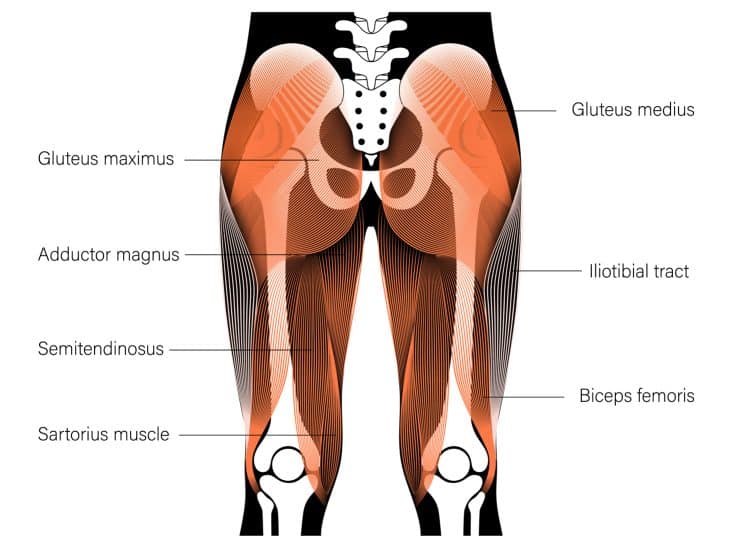
Gluteus maximus (the big glutes)
This is the muscle you are currently sitting on, but it’s more than just somewhere convenient to sit! The gluteus maximus is the largest muscle in the human body and also potentially the most powerful. Located on the back and lower aspect of your hip, the functions of the gluteus maximus are:
- Hip extension
- Lateral (external) hip rotation
- Hip abduction (superior or upper portion)
- Hip adduction (inferior or lower portion)
Gluteus minimus (the middle glutes)
This is a small triangle-shaped muscle located within the posterior region of the hip. The Gluteus minimus works alongside the gluteus maximus, and its functions are:
- Hip abduction
- Hip medial rotation
- Pelvis stabilization
Gluteus medius (the upper glutes)
The gluteus medius is located above and beneath the gluteus maximus near the iliac crest at the top of the pelvis. This is the muscle that, when developed, will give your butt its shelf-like appearance. Gluteus medius works alongside gluteus maximus and minimus, and has several essential functions.
- Hip abduction (movement away from the midline of the body)
- Hip medial (internal) rotation
- Pelvis stabilization
As you can see, the three glute muscles share many of the same functions, and almost always work together. However, it is possible to emphasize one region over the others by performing specific movements and exercises.
Benefits of Strengthening the Gluteus Medius Muscle
While many people are keen to develop their gluteus maximus, the gluteus medius is often neglected or only trained for aesthetic purposes. However, there are benefits to strengthening your gluteus medius that goes beyond muscle size and appearance.
Improved hip stability
Weak gluteus medius muscles can cause short and long-term hip pain. The hips are a highly mobile synovial ball and socket joint that needs to support a lot of weight. Loads on the hip increase exponentially during single-leg activities, such as walking and running.
Strengthening gluteus medius will support and stabilize your hips, preventing unwanted movement and reducing the risk of both acute and chronic hip pain.
Less risk of knee pain
The gluteus medius stops your hips from falling inward when you walk, run, jump, squat, and lunge. If this muscle is allowed to weaken, you could end up putting more stress on your knees, as they will cave inward too. So, if you have painful knees or just want to prevent future knee pain, strengthening your gluteus medius could help.
Less risk of back pain
One weak muscle group often affects the joints above and below the ones it controls. So, as weak hips can lead to knee pain, they can also cause problems with your lower back.
Unstable hips can lead to unwanted movement of your pelvis, sacrum, and lumbar spine, especially when walking, running, lifting, or squatting. Strengthening your glute complex, especially the gluteus medius, could help reduce the lateral shearing and rational forces on your lumbar spine, preventing lower back pain.
A better-looking butt
Bodybuilders work hard to develop muscular, balanced physiques. To do this, they make sure they hit all their major muscles from a variety of angles. For example, they’ll work their upper, middle, and lower pecs to build a perfect chest.
General glute training will sculpt a pretty good butt, but if you want your rear end to look its best, you need to include the gluteus minimus and medius in your workouts. Working all of the glute muscles equally gives you the best chance of developing a 3D butt that looks good from all angles.
Behavior That Could Be Weakening Your Gluteus Medius Muscle
Despite your best intentions, there may be a couple of things you are doing that have weakened your gluteus medius (1). Get more from your upper glute workouts and stop undermining your progress by avoiding these habits:
Standing with one hip stuck out to the side
This comfortable resting position stretches the gluteus medius on the side that’s bearing most of the weight. Stretching for long periods can inhibit a muscle and make it weaker. Stand with your weight spread evenly across both feet to avoid this problem.
Sitting with your legs crossed
Sitting with your leg crossed also puts your upper glutes into a stretched, inhibited position. While this might be a comfortable posture, if you sit with your legs crossed for hours at a time, you are literally putting your glutes to sleep.
Sleeping on your side
When you lie on your side, your uppermost leg falls inward, stretching the muscles outside your hip. The easiest way to prevent this problem is to sleep with a pillow between your knees.
Focusing too much on hip extension exercises
While the gluteus maximus is primarily a hip extender, it’s less involved in abduction. If you want to develop your gluteus medius and minimus, your workouts much include hip abduction exercises, too.
FAQs
Why are my glutes soft, small, or weak?
In many cases, glutes are weak from lack of use. Sure, you may train them a couple of times a week, but for the rest of the time, you spend most of your day sitting on your butt instead of flexing it!
All this inactivity causes atrophy and weakens the nerve impulses that feed your glutes. In short, they become lazy and start to turn off.
The good news is that the glutes are highly trainable, and hitting them a few times a week and being more physically active generally will soon bring them back “online.”
Focusing on your mind-muscle connection will also help. Practice contracting your glutes before your workout and on your days off, too. The better you are at tensing a muscle, the more effectively you can train it, and the firmer your glutes will be, even at rest.
Finally, look for daily opportunities to use your glutes more. Take stairs two at a time, walk whenever you can, even just standing on one leg while brushing your teeth will provide your glutes with mini-workouts throughout the day.
How many times a week should I train my glutes?
Three times a week is a good place to start for most people. This provides a good balance between work and recovery. For example, you could train your glutes and lower body Monday, Wednesday, and Friday, and your upper body Tuesday, Thursday, and Saturday.
If you can’t manage three times a week, twice should suffice. However, one workout per week probably won’t be enough to produce good results.
What rep range should I use for my glute workouts?
Your rep range is goal and exercise-dependent. To build strength, you need to lift heavy weights for low reps, i.e., 1-5. Of course, such heavy loads by not be practical for some glute exercises, such as clam shells, glute bridges, etc.
To build muscle, you can use light to moderate weights and do anywhere from 6-30 reps per set. In general, the lower end of the scale is best for compound exercises, e.g., sumo goblet squats. In contrast, the higher end is more suitable for isolation or single joint movements, e.g., cable abductions.
When training for hypertrophy or muscle growth, make sure you take your sets to within 1-3 reps of failure. Easier sets will not trigger much if any muscle growth.
How many sets should I do per week for my glutes?
The accepted number of sets per muscle group per week is 10-20. Beginners and older exercisers should do 10-14, while younger and more advanced exercisers can work up to 15-20. More sets will not produce better results.
These sets should be evenly spread over your workouts. For example, if you want to do 15 sets for your upper glutes per week, you could do three workouts, each consisting of five sets for the target muscle.
How long does it take to grow bigger glutes?
You should start seeing results from your training in 6-8 weeks, providing you are pushing yourself hard, getting plenty of rest and sleep, and being consistent. Your diet must also support your training.
That doesn’t mean you need to go on a diet, but what you eat needs to be healthy and provide the correct number of calories based on your goals.
Read more about how to create the perfect diet here.
How can I get more from my glute workouts and exercises?
One of the best ways to increase glute activation during leg workouts is to use a booty band. A booty band is a wide, short resistance band you wear around your knees.
When you push your knees outward, e.g., during squats or glute bridges, you’ll need to work harder to stabilize your hips which increases glute activation, particularly gluteus minimus and medius.
You can use a booty bend when doing many exercises, including freeweight, machine, and resistance band movements. You can do many of the exercises in this guide with a booty band to make them more glute-centric.
Closing Thoughts
The gluteus medius or upper glute is a small but essential hip muscle. It works alongside your other glutes (maximus and minimus), but it’s also possible to emphasize it by performing specific exercises. Building your upper glutes could help you develop a higher, wider butt and create that oh-so-appealing butt shelf!
Gluteus medius is not just a good-looking muscle; it’s also crucial for joint health and function. Strengthening your upper glutes could reduce your risk of hip, knee, and lower back pain.
So, hit your upper butt with the exercises outlined in this article. But remember; it’s just one of three glute muscles and one of 206 muscles in your body. So, by all means, emphasize your upper glutes, but don’t forget all those other muscles. They deserve your love and attention, too!
References:
- Strength and Conditioning Journal: Gluteus Medius: Applied Anatomy, Dysfunction, Assessment, and Progressive Strengthening https://journals.lww.com



